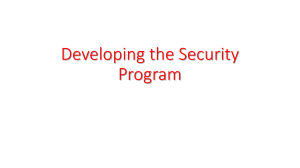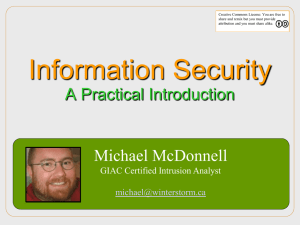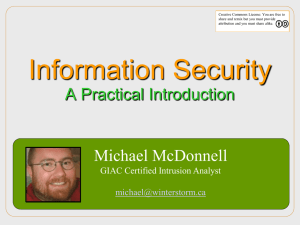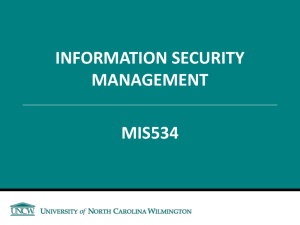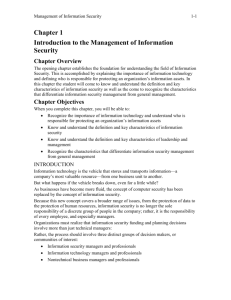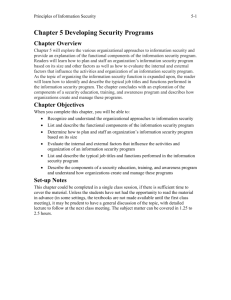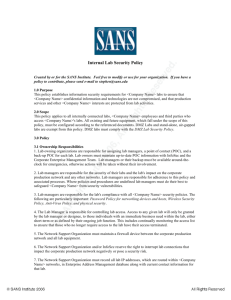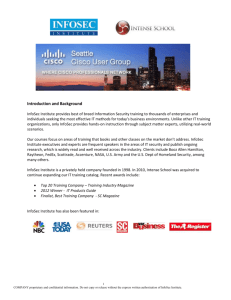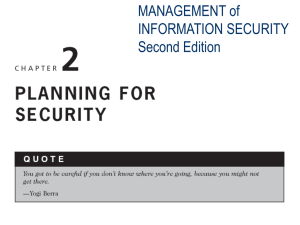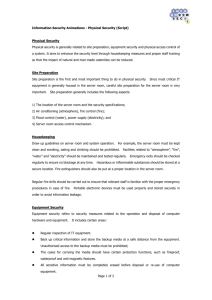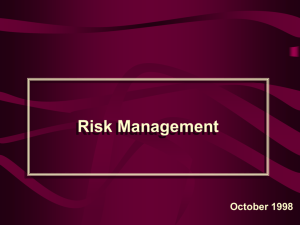MoIS4 CH02 Review Questions
advertisement
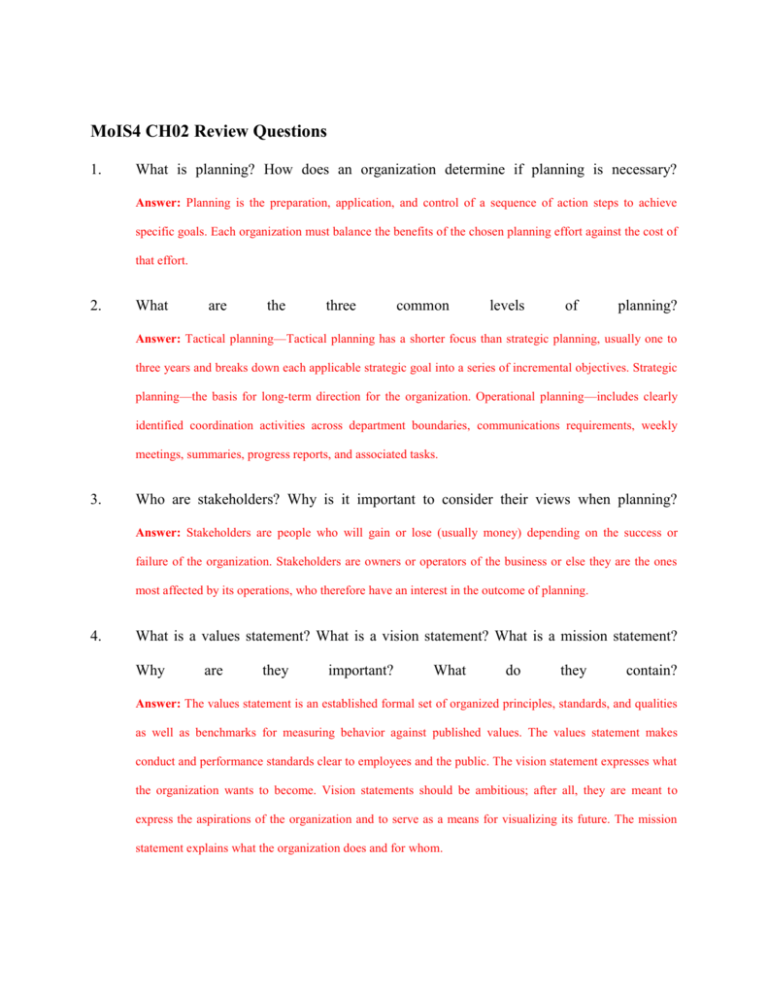
MoIS4 CH02 Review Questions 1. What is planning? How does an organization determine if planning is necessary? Answer: Planning is the preparation, application, and control of a sequence of action steps to achieve specific goals. Each organization must balance the benefits of the chosen planning effort against the cost of that effort. 2. What are the three common levels of planning? Answer: Tactical planning—Tactical planning has a shorter focus than strategic planning, usually one to three years and breaks down each applicable strategic goal into a series of incremental objectives. Strategic planning—the basis for long-term direction for the organization. Operational planning—includes clearly identified coordination activities across department boundaries, communications requirements, weekly meetings, summaries, progress reports, and associated tasks. 3. Who are stakeholders? Why is it important to consider their views when planning? Answer: Stakeholders are people who will gain or lose (usually money) depending on the success or failure of the organization. Stakeholders are owners or operators of the business or else they are the ones most affected by its operations, who therefore have an interest in the outcome of planning. 4. What is a values statement? What is a vision statement? What is a mission statement? Why are they important? What do they contain? Answer: The values statement is an established formal set of organized principles, standards, and qualities as well as benchmarks for measuring behavior against published values. The values statement makes conduct and performance standards clear to employees and the public. The vision statement expresses what the organization wants to become. Vision statements should be ambitious; after all, they are meant to express the aspirations of the organization and to serve as a means for visualizing its future. The mission statement explains what the organization does and for whom. 5. What is strategy? Answer: A strategy is a method to accomplish a specific objective. It often forms the basis for the organization’s long-term direction. Strategy normally sets guidelines for organizations efforts and focuses resources toward specific, clearly defined goals. 6. What Answer: is InfoSec governance? InfoSec governance includes all the accountabilities and methods undertaken by a board of directors and executive management to provide strategic direction, establishment of objectives, measurement of progress toward those objectives, verification that risk management practices are appropriate, and validation that the organization’s assets are used properly. 7. What should a board of directors recommend as an organization’s InfoSec objectives? Answer: 1. Inculcating a culture that recognizes the criticality of information and organization 2. Verifying that management’s investment in InfoSec to the InfoSec is properly aligned with organizational strategies and the organization’s risk environment 3. Assuring that a comprehensive InfoSec program is developed and implemented 4. Demanding reports from the various layers of management on the InfoSec program’s effectiveness and adequacy. 8. What are the five basic outcomes that should be achieved through InfoSec governance? Answer: 1. Strategic alignment of InfoSec with business strategy to support organizational objectives 2. Risk management by executing appropriate measures to manage and mitigate threats to information resources 3. Resource management by utilizing InfoSec knowledge and infrastructure efficiently and effectively 4. Performance measurement by measuring, monitoring, and reporting InfoSec governance metrics to ensure that organizational objectives are achieved 5. Value delivery by optimizing InfoSec investments in support of organizational objectives. 9. Describe top-down strategic planning. How does it differ from bottom-up strategic planning? Which is usually more effective in implementing security in a large, diverse organization? Answer: Top-down strategic planning involves high-level managers providing resources and giving directions. Directors issue policies, procedures, and processes and dictate the goals and expected outcomes of the project, and also determine who is accountable for each of the required actions. In top-down planning, managers give directions on how projects should be handled, while in bottom-up planning, system administrators give directions on how projects should be handled. Of the two, top-down planning is the more effective security strategy, since it encompasses critical features such as coordination between departments, coordinated plans from top management, provision of sufficient resources, and support from end users. 10. How does the SecSDLC differ from the more general SDLC? Answer: The SecSDLC is more closely aligned with risk management practices and involves extensive effort in identification of specific threats and risks and subsequent design and implementation of specific controls to counter those threats and assist in management of the risk, while SDLC involves the general methodology for design and implementation of an information system in an organization. 11. What is the primary objective of the SecSDLC? What are its major steps, and what are the major objectives of each step? Answer: The primary objective of the SecSDLC is the identification of specific threats and the risks that they represent, and the subsequent design and implementation of specific controls to counter those threats and assist in the management of the risk. The major steps and their objectives are: Investigation—Beginning with a directive from upper management specifying the process, outcomes, and goals of the project as well as its budget and other constraints, involves validating the directive and also the affirmation or creation of security policies on which the security program of the organization is or will be founded. Analysis—The documents from the investigation phase are studied. Logical design—The team members create and develop the blueprint for security, and examine and implement key policies that influence later decisions. Physical design—Team members evaluate the technology needed to support the security blueprint, generate alternative solutions, and agree upon a final decision. Implementation—The security solutions are acquired, tested, implemented, and tested again. Maintenance—Information systems are constantly monitored, tested, modified, updated, and repaired. This is the most important phase. 12. What is a threat in the context of InfoSec? What are the 12 categories of threats presented in this chapter? Answer: A threat is an object, person, or other entity that represents a constant danger to an asset. The 12 threat categories are: acts of human error or failure, compromises to intellectual property, deliberate acts of espionage or trespass, deliberate acts of information extortion, deliberate acts of sabotage or vandalism, deliberate acts of theft, deliberate software attacks, forces of nature, deviations in quality of service from service providers, technical hardware failures or errors, technical software failures or errors, and technological obsolescence. 13. What is the difference between a threat and an attack? Answer: A threat is the danger that a system might be attacked, whereas an attack is a deliberate act that exploits a vulnerability. 14. How can a vulnerability be converted into an attack? Answer: A vulnerability can be converted into an attack by a threat agent if it is not addressed. 15. What name is given to an attack that makes use of viruses and worms? What name is given to an attack that does not actually cause damage other than wasted time and resources? Answer: (a) malicious code (b) hoax 16. What questions might be asked to help identify and classify information assets? Which is the most important question to ask? Answer: 1. Which information asset is the most critical to the success of the organization? 2. Which information asset generates the most revenue? 3. Which information asset generates the most profitability? 4. Which information asset would be the most expensive to replace? 5. Which information asset would be the most expensive to protect? 6. Which information asset would be the most embarrassing or cause the greatest liability if revealed? The most important question varies subjectively, but sound arguments can be made for numbers 2 and 3. 17. What name is given to the process of assigning a comparative risk rating to each specific information asset? What are the uses of such a rating? Answer: Risk assessment is the name given to the process of assigning a comparative risk rating to each specific information asset. The rating is useful in gauging the relative risk introduced by each vulnerable information asset and allows us to make comparative ratings later in the risk control process. 18. What term is used to describe the provision of rules intended to protect the information assets of an organization? Answer: Information policy is the term given for the provisioning of rules used to protect the information assets of an organization. 19. What term is used to describe the control measure that reduces security incidents among members of the organization by familiarizing them with relevant policies and practices in an ongoing manner? Answer: Security education and training program (SETA). 20. What are the three categories of InfoSec controls? How is each used to reduce risk for the organization? Answer: The three categories of InfoSec controls are managerial controls, operational controls, and technical controls. Managerial controls cover security processes that are designed by the strategic planners and performed by the security administration of the organization. Operational controls address personnel security, physical security, the protection of production inputs and outputs, management functions, and disaster recovery planning. Technical controls address the specifics of technology selection and the acquisition of certain technical components, including logical access controls like identification, authentication, authorization, and accountability.
